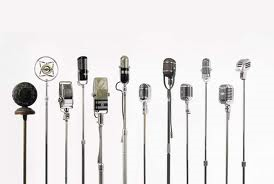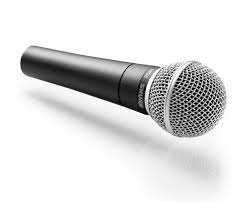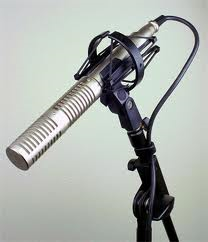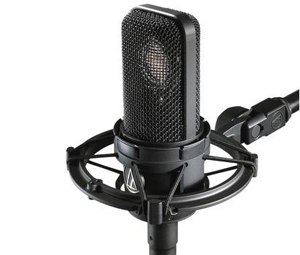Picking a microphone PT1:
If I could only have one mic?!

In most home recording projects, budget is a major issue in separating our fantasy of gold plated albums on our walls, and our reality of hanging blankets over the windows, hoping it cuts down on some of the noise leaking out into our neighbors apartment. Our first studio is probably not going to have a mic locker with two kinds of every mics for any occasion. Instead, it is going to have one mic that will record everything! If we are going to invest in our first mic, or one that is going to have multiple uses, we should invest smart and buy something that will give a bang for our buck in the production department.
While you can literally play acoustic guitar into a lavalier microphone (one of those tiny mics that clip to your shirt collar) and record it, it will not give us as clear of recording as using a Neumman U87 placed properly. A Lavalier microphone is good for recording human speech, it is not ideal for recording instruments. The Neumann U87 is a Large Diaphragm Condenser (LDC) microphone and is great for Voice Overs (VO), Vocals, Rapping and recording live instruments. For reference, a Neumman U87 is approximately $3,500.00 ( http://www.sweetwater.com/store/detail/U87SetZ/ ) This places the U87 out of most small recording room start up budgets. (Don't forget we still need a computer, software, soundcard, monitors, headphones ..$$$.ahhh!!!)
There are basically three main types of microphones you will be considering when starting your home studio. They are:
Dynamic Microphone - These microphones are the ones vocalists use live on stage. They are durable and overall cost much less than the other types of microphones. A couple popular or the Shure SM 58 and the Shure SM 57. Both used in many productions and live performances and both cost around $100.00. They are also very good at rejecting noise and only picking up the sound coming durectly into the capsule. This makes it ideal for live use, where there is sound coming from all over the dang place. The downside of the Dynamic Microphone is that they are not great at picking up subtle performances without cranking the gain, which could introduce other noise into your recording. I find they also do not reproduce frequencies as accurately as the condenser microphones. These are great for live performances, “ok” for recording vocals and not ideal for recording the majority of acoustic instruments. (They can be great for recording percussion and micing drums, due to their noise cancellation from anything not in front). They are probably the kind of microphone the kid at Guitar Center is going to try and sell you when you pop in and say “Yo I need a phat mic to record my skillz, whatchyou got for me?”
cost much less than the other types of microphones. A couple popular or the Shure SM 58 and the Shure SM 57. Both used in many productions and live performances and both cost around $100.00. They are also very good at rejecting noise and only picking up the sound coming durectly into the capsule. This makes it ideal for live use, where there is sound coming from all over the dang place. The downside of the Dynamic Microphone is that they are not great at picking up subtle performances without cranking the gain, which could introduce other noise into your recording. I find they also do not reproduce frequencies as accurately as the condenser microphones. These are great for live performances, “ok” for recording vocals and not ideal for recording the majority of acoustic instruments. (They can be great for recording percussion and micing drums, due to their noise cancellation from anything not in front). They are probably the kind of microphone the kid at Guitar Center is going to try and sell you when you pop in and say “Yo I need a phat mic to record my skillz, whatchyou got for me?”

Small Diaphragm Condenser Microphone (SDC) – These microphones are generally very accurate and great for detailing instruments with fast transients (a transient is a high amplitude, short-duration sound at the beginning of a waveform), such as drum hits, acoustic guitars and even pianos. They sensitive and have a great high frequency response range, much better than a Dynamic microphone. They generally require 48V phantom power, which most inputs of todays soundcards and consoles provide.
Large Diaphragm Condenser Microphone (LDC) – These microphones are my first choice if you were only to have one studio mic. Generally they record very accurately and are known for a warmer tone than their SDC counterparts. They are great for recording vocals and acoustic instruments. They generally have a very responsive low end, making them great for recording bass and kick drums when needs as well. They are my “go to” studio mic. Like the SDC, they will also need 48V phantom power, which will usually be supplied in any of today's sound cards or consoles.
are known for a warmer tone than their SDC counterparts. They are great for recording vocals and acoustic instruments. They generally have a very responsive low end, making them great for recording bass and kick drums when needs as well. They are my “go to” studio mic. Like the SDC, they will also need 48V phantom power, which will usually be supplied in any of today's sound cards or consoles.
A word about mic quality. A microphone is (not so) arguably the most important step in your signal chain. If you are serious about making decent quality recordings, I suggest saving your money and investing wisely in a quality microphone. While $$$ does not always mean quality, it's a safe bet that $25 dollar USB mic is not going to sound as good as the $1,500 dollar LDC mic. Some microphones also pair better than others with certain voices, styles and instruments. For instance, I recently recorded a female vocalists with a Neumman U87 (arguably the most popular vocal mic in recording history). After a couple songs, I was not getting the tone out of the mic I needed. I changed to a Shure KSM 44 (LCD) and it sounded noticeably better with her voice. (By comparison, the KSM 44 is a $1,500 dollar mic)
There are several other kinds of mics that will be discussed in future articles, but these main three should get you off and running.
Mike Lizotte
1 thought on “Picking a Microphone”